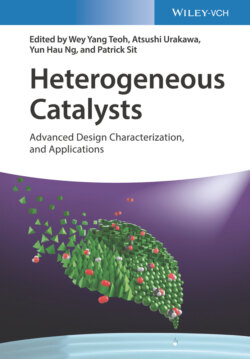Читать книгу Heterogeneous Catalysts - Группа авторов - Страница 23
2.3.1 Anisotropic Adsorption
ОглавлениеHeterogeneous reaction takes place on a catalyst surface (most commonly as solid) where phase differs from that of the reactants [33]. In a typical case, the process consists of three steps, adsorption, reaction, and desorption occurring at the catalyst surface. The effective adsorption, which is an essential step during heterogeneous reaction, is largely related to the exposed atomic structures of the catalyst surface. Because the surface atomic arrangement and coordination vary in different crystal facets, adsorption energy and states of the reactant molecules are different on various exposed facets. This variation of adsorbing states has a profound impact on the subsequent catalytic steps.
Various surface science studies have been performed to investigate the interactions between the different surface facets of metals or semiconductors, and the reactant molecules. Platinum, being one of the most versatile metal catalysts, has an fcc crystal structure and is one of the most studied surfaces. On the flat surface, such as Pt{100} and Pt{111}, each platinum atom is surrounded by four and six adjacent neighbors, respectively. These two low‐index facets have highest atomic density. High‐index facets, such as Pt{530} and Pt{730}, contain many terrace structure and steps with low‐coordinated atoms [34]. The atomic arrangement of Pt{730} facet is periodically overlapped with one Pt{310} subfacet and two Pt{210} subfacets, leading to a multiple‐height terrace structure. Furthermore, the faceted metal catalysts have more atoms located at the edges and corners, where they have much lower atomic density and coordination, which can have a profound impact on surface adsorption.
Titanium dioxide (TiO2) has been the most intensively investigated binary transition metal oxide as a photocatalyst, where many theoretical calculations have been conducted to investigate the interactions between water molecules and the TiO2 surface [35]. Because the water molecule is one of the most important adsorbates present in many photocatalytic reactions, such as water splitting, photodegradation of organic pollutants, and CO2 reduction, many experimental and theoretical studies have focused on this aspect [36–40]. Anatase {101}, {001}, and {100} surfaces are three typical low‐index surfaces of anatase TiO2. Anatase {101} contains 50 % sixfold coordinated (Ti6c) Ti atoms (saturated) and 50 % fivefold coordinated (Ti5c) Ti atoms (unsaturated), whereas anatase {001} and {100} surface contains 100% Ti5c atoms. Most theoretical and experimental results suggest molecular adsorption of water on the defect‐free {101} surface [41] but dissociative adsorption of water molecules on the {001} surface at low coverages (shown in Figure 2.3) [36]. The dissociative adsorption of water is also favorable on the anatase {100} surface [12].
Figure 2.3 Side view of anatase TiO2 {101} and {001} facets. Top view for adsorbed water molecules on anatase {101} surface and side view of adsorbed water molecules on anatase {001} surface.
Source: Vittadini et al. 1998 [36]. Reproduced with permission of American Physical Society.
